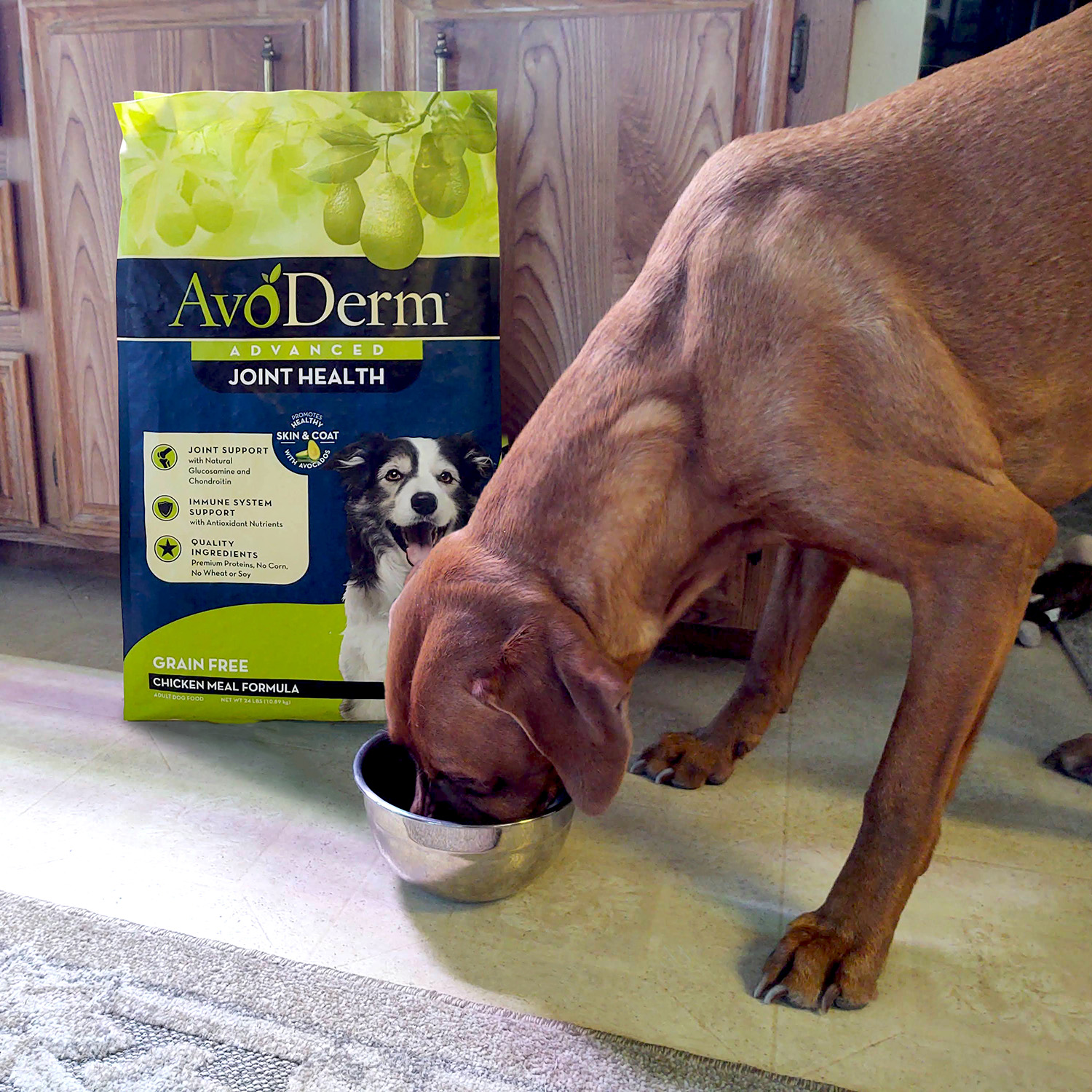By Rick Rockhill, COO
The amount of conflicting information on the internet about dog and cat nutrition can be challenging to interpret and understand. Often times there are hidden agendas or scare tactics to influence the consumer. Here at AvoDerm Pet Foods, we use science as our guide. But what about things like protein levels, legumes, carbohydrates, peas, sweet potatoes, avocados, brown rice…the list of questions is exhausting.
How do we decide what goes into a pet food formula?
First and foremost, our formulas are rooted in the facts of science, knowledge of extrusion cooking, and the needs of the animal. Extrusion is a method of cooking raw ingredients so they form into the shape of a kibble. Kibble is a modern wonder of science. Kibble delivers all the nutrients the dog or cat needs to be healthy. Extrusion does not “cook out nutrients” or deplete the nutrition. We plan a formula and anticipate the final product after cooking, much like you would do when roasting a turkey or baking a cake. You start with raw ingredients, blend, mix, and cook. Do not be fooled that extrusion kibble is “bad” or “burnt” or “not nutritious”. Those are myths created by people who just want to sell their own type of food. Kibble, is actually well established as the ideal food method for well over 60 years, and continues to evolve and develop over the years.
Our diets are for formulated based on the total nutritional requirements of the dog or cat. We do not formulate merely for the crude protein levels, or to manipulate the first few ingredients on an ingredient panel. We formulate to meet the total needs for the intended purpose (growth, all life stage, etc.).
Using science and fact as a guide, we establish protein levels, along with levels of fat, carbohydrates, and fiber at optimal levels for peak performance. We do not distort one nutrient just for marketing purposes to “win” a sale. Beware of salespeople or slick marketers who try to convince you to only focus on a few ingredients. Nutrition is more complex than just protein alone.
Individual ingredients contribute different nutrients and in total ensure the diet meets the requirements for the animal. Science shows that animals thrive with a variety of sources of protein from both meat and vegetables. Protein is an important component in pet food, so consumers often ask about the protein source. Depending on the formula, a very high percent of the protein usually does come from either meat or fish, with additional protein being plant-based (quinoa, chickpeas, peas, brown rice, sweet potatoes, etc.).
To make pet foods properly requires extensive knowledge of how nutrients react when cooked, how bioavailable they are when digested, and how those nutrients affect a pet’s gut health. Strong knowledge of animal physiology and digestion is also necessary. Some nutrients become more bioavailable to the animal when cooked. Every single dietary ingredient matters. Each ingredient is part of a very precise dietary matrix used to meet the nutrient requirements of the animal. Too much of one ingredient could cause an imbalance. Ingredients have unique nutrient profiles that must be considered and factored properly. An experienced nutritionist understands how the ingredients, in total, will perform to support the animal’s health.
In our grain-free cat and dog diets, we incorporate several plant-based ingredients to ensure the formula is balanced with protein, fiber, fat, carbohydrates, vitamins and minerals. Our grain-free diet ingredient labels list some ingredients that may look similar and are listed separately. For example, we use different fractions of peas, also known as legumes. Each has a different purpose and nutritional value, such as whole peas, pea starch, and pea flour. These main ingredients are quite different from one another and they not listed differently for the benefit of the label listing to mislead a consumer (sometimes incorrectly referred to as “ingredient splitting”). The reason we use different versions of the pea is because of what they contribute in their different form. Each ingredient is prepared in a specific manner and, as such, can be more concentrated in nutrients such as protein, or certain essential vitamins and minerals, and also provide different types of fiber.
Examples:
- Dried Peas: We start with fresh, whole green peas and dry them to remove much of the water. Peas consist of the entire pod and are an excellent source of protein, fiber, niacin, Vitamin B6, Vitamin A, Folate, Phosphorus, and Potassium. Whole peas have roughly 25% protein on a dry matter basis, along with starch, fiber and a small amount of oils.
- Pea Starch: We cook, dehydrate and isolate only the starch component. Pea starch aids with the binding structure and shape of the dry kibble.
- Pea Flour: We split and dry the pea, then grind it to a very fine flour consistency. It is a high quality, digestible source of protein, fiber, and vitamins. Pea flour typically contains about 60% starch, 12% protein, and 25% total dietary fiber.
Each of these has a different utility when added at select percentages, to a complete recipe, and it is very common to use varying concentrations of each in a complete recipe as they supply various nutrients to benefit the dog or cat. These are each listed separately because they have a different purpose and are what is right for the animal’s optimal nutrition and health.
It is important not to assume that because the ingredients may sound similar, they have been listed differently to alter the perception of the label. We are proud of the quality of ingredients we use, from the very first item listed right through to the very last ingredient. We can say this because we only use high-quality ingredients with a nutritional purpose and test every raw material before we allow it into our own plant in Irwindale, California.
Despite what some brands of pet food offer, dogs and cats bodies will not absorb or utilize protein beyond a specific level. I do not saw this as a criticism, I state that as a fact. It is also our nutritional philosophy that excessive protein levels can unnecessarily tax some vital organs. Carbohydrates are the preferred source of energy for dogs and cats and are well utilized by both species. Nutritionists can vary in their views about the amount of carbohydrates in a formula, or the type of carbohydrate (brown rice versus white rice, or sweet potato versus millet or oatmeal, etc.).
There is no scientific or nutritional reason to reduce their concentration of carbohydrates in dog and cat foods. The cooking process of extruding and retorting pet food cooks the starch ingredients, making them nearly completely available to the animal, similar to other ingredients. There are many examples of carbohydrates (such as peas, lentils, chickpeas, sweet potatoes, tapioca, potato, and others) that are very healthful ingredients. These all have an excellent carbohydrate, fiber, and protein composition, and are excellent carbohydrate sources in quality pet foods.
To illustrate this further when we formulate, we are not only looking at Protein, Fat, Fiber and Moisture levels, we take into consideration the amino acid profile, fiber, vitamins, minerals; in fact 53 nutrient components listed below:
- Arginine
- Histidine
- Isoleucine
- Leucine
- Lysine
- Methionine-Cystine
- Methionine
- Phenylalanine-Tyrosi
- Phenylalanine
- Threonine
- Tryptophan
- Valine
- Calcium
- Phosphorous
- Ca:Phos
- Potassium
- Sodium
- Chloride
- Magnesium
- Iron
- Copper
- Manganese
- Zinc
- Iodine
- Selenium
- Vitamin A
- Vitamin D
- Vitamin E
- Vitamin K
- Thiamine
- Riboflavin
- Pantothenic acid
- Niacin
- Pyridoxine
- Folic acid
- Biotin
- Vitamin B12
- Choline
- Taurine
- Omega 3 FA
- Omega 6 FA
- Linoleic acid
- Arachidonic acid
- ALA 18:3n3
- EPA 20:5n3
- DPA 22:5n3
- DHA 22:6n3
- EPA + DHA
- TDF
- Carnitine
- Vitamin C
- Sulfur
- Phosphorus, available
We have a team of experienced nutritionists, companion animal University Professors, Doctors, Pet Food Safety Chemists, and Technicians who ensure what we produce in our plant is safe and healthy for your dog or cat. I would encourage you to check out our Pet Food Safety Lab™ website to see how seriously we take ingredients and safety. We check every raw material for safety and to ensure it meets the specification required to be used in our plant.
The bottom line is that you can trust AvoDerm Pet Foods because our nutrition is balanced and healthy, not just a fad to convince you to buy it. Our foods are proven healthy from over 30 years of testimonials, and we welcome you to contact us any time with any questions at all.
-Rick Rockhill
Chief Operating Officer





